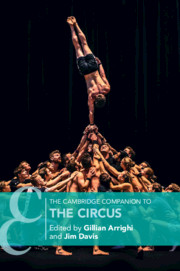Book contents
- The Cambridge Companion to the Circus
- Cambridge Companions to Theatre and Performance
- The Cambridge Companion to the Circus
- Copyright page
- Contents
- Figures
- Contributors
- Acknowledgements
- Timeline
- Introduction
- Part I Transnational Geographies of the Modern Circus
- Part II Circus Acts and Aesthetics
- Part III Circus
- Chapter 11 Circus and Somatic Spectacularity on Stage in the Variety Era
- Chapter 12 Becoming an Art Form
- Chapter 13 Risky Play and the Global Rise in Youth Circus
- Chapter 14 Social Circus
- Part IV Circus Studies Scholarship
- Bibliography
- Index
- References
Chapter 11 - Circus and Somatic Spectacularity on Stage in the Variety Era
from Part III - Circus
Published online by Cambridge University Press: 22 June 2021
- The Cambridge Companion to the Circus
- Cambridge Companions to Theatre and Performance
- The Cambridge Companion to the Circus
- Copyright page
- Contents
- Figures
- Contributors
- Acknowledgements
- Timeline
- Introduction
- Part I Transnational Geographies of the Modern Circus
- Part II Circus Acts and Aesthetics
- Part III Circus
- Chapter 11 Circus and Somatic Spectacularity on Stage in the Variety Era
- Chapter 12 Becoming an Art Form
- Chapter 13 Risky Play and the Global Rise in Youth Circus
- Chapter 14 Social Circus
- Part IV Circus Studies Scholarship
- Bibliography
- Index
- References
Summary
The transatlantic circulation of circus acts during the late-nineteenth and early-twentieth centuries created opportunities for circus’s somatically spectacular acts to appear on pantomime and variety theatre stages. This chapter assesses a neglected aspect of circus scholarship: understanding how and why circus acts appeared in other popular entertainment forms. Circus, pantomime, and variety cultivated unity through their reliance on novelty. By tracing the performance engagements of a major circus-style act, Lockhart’s Elephants, in iconic variety venues in London, Paris, and New York City, I demonstrate the deep interrelatedness of modern circus and music hall/vaudeville. Performers frequently established and sustained their reputations in these economically powerful cosmopolitan centres, where heightened competition in the leisure marketplace increased circulation of circus performers. Nineteenth-century industrialisation and changing theatre regulations had transformed genres, allowing audiences more opportunity for leisure activities and theatres more opportunity to blur spoken drama and spectacle. The somatic spectacularity of circus acts provided essential counterpoints to pantomime and variety’s dominant performance modes. This dynamic relationship complicates our understanding of circus, pantomime, and variety as distinct genres, pressing scholars to reconsider the relative stability with which we deploy the terms and write their histories.
- Type
- Chapter
- Information
- The Cambridge Companion to the Circus , pp. 171 - 187Publisher: Cambridge University PressPrint publication year: 2021



